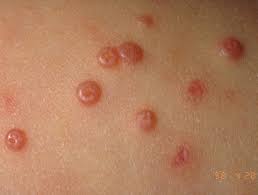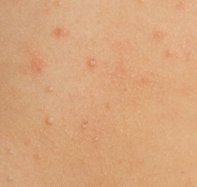If you’re wondering what is molluscum and what are the common molluscum symptoms, you’ve come to the right place. We’ll explain the condition, its symptoms, how it’s spread and its treatment options. We’ll also tell you how molluscum symptoms differ from warts, a condition which is often confused with molluscum.
What is Molluscum Contagiosum?
Molluscum contagiosum is a skin condition caused by a virus that is part of the pox family. Yes, the same pox family that viruses like small pox and chicken pox belong to. Fortunately, molluscum is much less serious than those conditions.
Like chicken pox, molluscum contagiosum will usually go away on its own without any special treatment. Unlike chicken pox, however, molluscum can take a long time to go away on its own and people with the condition often inadvertently keep spreading it to other areas of their bodies while waiting for it to clear up.
Like chicken pox, if you scratch affected areas of the body very much, you may develop scarring or infection. Fortunately, molluscum is not always as itchy as chicken pox typically is. Some people with the condition do experience quite a bit of itchiness, though.
Like other pox viruses, molluscum contagiosum is highly contagious. You can spread it to others with casual contact or it can be passed to others on items like clothing, towels or bed linens.
What are Common Molluscum Symptoms?
The most common symptom is small bumps that resemble warts. The bumps are usually smaller than a pencil eraser, smooth and flesh-colored or just a bit darker. Sometimes you can see a very tiny opening at the center of each bump. If you squeeze the bump, the core may shoot out, much like a whitehead (but we recommend you don’t squeeze them as that can lead to infection and scarring and can also cause the condition to spread).
Molluscum symptoms may also include dry, flaking skin around the bumps and itching. The itching, when it occurs, varies in severity from minor to significant.
How Do Molluscum Symptoms Differ from Warts?

Warts are often brown or gray in color and rough instead of smooth. While people may have more than one wart, they seldom have as many warts as molluscum bumps; it’s common for a person to have up to 30 molluscum bumps in one area. Warts do not have a tiny opening in the center, either, and if squeezed, there is no core that will pop out. However, you can sometimes see tiny black dots inside a wart, which are clotted blood vessels. Click here to learn more about warts.
How can you tell what is molluscum and what is a wart if they look too much alike? A physician can often tell the difference just by looking at the affected area, but if not, a skin scraping can be done to confirm the diagnosis.
What is Molluscum Treatment?
Conventional molluscum treatment is similar to conventional treatment of warts and involves things like freezing off the bumps (cryotherapy), burning off the bumps (electrocautery), scraping them off with a surgical instrument, removing them with laser therapy and treating them with chemotherapy cream. Many people are reluctant to undergo those kinds of treatments, though, due to concerns about pain, scarring and other unwanted side effects.
So what is molluscum treatment that we recommend? Well, we recommend trying a natural treatment before undergoing more aggressive treatments like those described above. We suggest a product like Naturasil Molluscum, which is made from plant extracts that simply cause the bumps to dry up and painlessly flake away. We recommend using it along with Naturasil Immune Renew, which strengthens your immune system so that it can fight off the virus itself and prevent the condition from spreading. Just follow this link to the Naturasil Website to learn more.
More than What is Molluscum on our Main Skin Molluscum Page
Healthy Skin Guide Home Page
